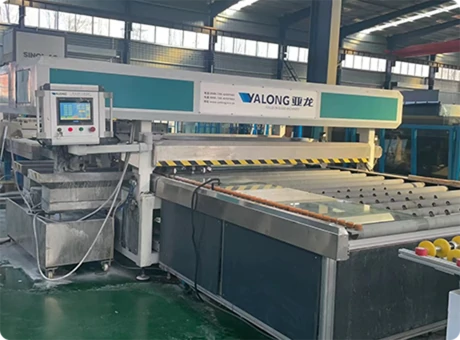Float Glass Making A Modern Approach to Glass Production
Float glass is a fundamental material in today’s architectural and industrial landscapes, known for its clarity, uniform thickness, and excellent light transmission properties. The process of making float glass is a remarkable blend of art and science, encompassing sophisticated technology and traditional techniques that have been refined over the years.
The Inventive Process
The float glass manufacturing process was invented in the 1950s by Sir Alastair Pilkington, a British glassmaker. His innovative technique revolutionized the glass industry by producing sheets of glass with a smooth, flat surface that is achieved by floating molten glass on top of molten tin. This method allows for the production of large panels of uniform thickness, which has become essential for various applications, from windows to mirrors and beyond.
The process begins with the careful selection of raw materials. The primary ingredients used in float glass production include silica sand, soda ash, dolomite, and other additives, such as calcium and magnesium. These raw materials are mixed in precise proportions to achieve the desired properties of the finished product. The mixture is then melted in a furnace at extremely high temperatures, around 1,700 degrees Celsius (3,092 degrees Fahrenheit), resulting in a molten glass.
The Floating Process
Once the glass is melted, it is funneled into a large, horizontal floating bath filled with molten tin. The key aspect of this process is the difference in densities between glass and tin; molten glass is less dense than tin, which allows the glass to float on the surface. As the glass flows over the tin, it spreads out into a large sheet, creating a flat, even surface.
This floating process not only produces a smooth surface on both sides of the glass but also allows for precise control over the thickness of the sheet. By adjusting the speed at which the glass moves through the tin bath, manufacturers can create sheets of varying thickness, generally ranging from 2 mm to 19 mm. After the desired thickness is achieved, the glass moves along the production line and passes through a cooling process, which is also carefully controlled to avoid any stresses in the glass.
float glass making
Cutting and Finishing
After cooling, the continuous sheet of float glass is cut into manageable sizes. This is typically done using extremely sharp diamond saws, which can cut glass with precision. The cut pieces are then inspected for quality, ensuring that they meet rigorous industry standards. Any imperfections may result in rejection, as float glass must be devoid of bubbles, waves, or distortions for its intended applications.
To enhance its properties, float glass can undergo various finishing processes, such as annealing, polishing, and coating. Annealing involves slowly cooling the glass to relieve internal stresses, ensuring its strength and durability. Coatings, such as low-emissivity (low-E) or reflective coatings, can also be applied to improve thermal efficiency and reduce glare, making float glass suitable for energy-efficient buildings.
Industry Impact and Sustainability
The float glass industry is continually evolving, with ongoing research and development aimed at improving energy efficiency and reducing environmental impact. Modern float glass plants are increasingly adopting sustainable practices, including recycling glass waste and implementing renewable energy sources to power their operations.
The versatility of float glass makes it indispensable in various applications, from construction and automotive industries to electronics and solar panels. Its ability to be manipulated and manufactured in a wide range of specifications ensures that it remains a vital component in modern society.
In conclusion, the float glass making process is a testament to human innovation and technological advancement. Its integration of scientific principles with practical manufacturing techniques has not only provided us with a superior product but also paved the way for more sustainable practices in the glass industry. As we continue to explore and develop new applications for glass, the future looks bright, quite literally, thanks to float glass.
 Afrikaans
Afrikaans  Albanian
Albanian  Amharic
Amharic  Arabic
Arabic  Armenian
Armenian  Azerbaijani
Azerbaijani  Basque
Basque  Belarusian
Belarusian  Bengali
Bengali  Bosnian
Bosnian  Bulgarian
Bulgarian  Catalan
Catalan  Cebuano
Cebuano  Corsican
Corsican  Croatian
Croatian  Czech
Czech  Danish
Danish  Dutch
Dutch  English
English  Esperanto
Esperanto  Estonian
Estonian  Finnish
Finnish  French
French  Frisian
Frisian  Galician
Galician  Georgian
Georgian  German
German  Greek
Greek  Gujarati
Gujarati  Haitian Creole
Haitian Creole  hausa
hausa  hawaiian
hawaiian  Hebrew
Hebrew  Hindi
Hindi  Miao
Miao  Hungarian
Hungarian  Icelandic
Icelandic  igbo
igbo  Indonesian
Indonesian  irish
irish  Italian
Italian  Japanese
Japanese  Javanese
Javanese  Kannada
Kannada  kazakh
kazakh  Khmer
Khmer  Rwandese
Rwandese  Korean
Korean  Kurdish
Kurdish  Kyrgyz
Kyrgyz  Lao
Lao  Latin
Latin  Latvian
Latvian  Lithuanian
Lithuanian  Luxembourgish
Luxembourgish  Macedonian
Macedonian  Malgashi
Malgashi  Malay
Malay  Malayalam
Malayalam  Maltese
Maltese  Maori
Maori  Marathi
Marathi  Mongolian
Mongolian  Myanmar
Myanmar  Nepali
Nepali  Norwegian
Norwegian  Norwegian
Norwegian  Occitan
Occitan  Pashto
Pashto  Persian
Persian  Polish
Polish  Portuguese
Portuguese  Punjabi
Punjabi  Romanian
Romanian  Russian
Russian  Samoan
Samoan  Scottish Gaelic
Scottish Gaelic  Serbian
Serbian  Sesotho
Sesotho  Shona
Shona  Sindhi
Sindhi  Sinhala
Sinhala  Slovak
Slovak  Slovenian
Slovenian  Somali
Somali  Spanish
Spanish  Sundanese
Sundanese  Swahili
Swahili  Swedish
Swedish  Tagalog
Tagalog  Tajik
Tajik  Tamil
Tamil  Tatar
Tatar  Telugu
Telugu  Thai
Thai  Turkish
Turkish  Turkmen
Turkmen  Ukrainian
Ukrainian  Urdu
Urdu  Uighur
Uighur  Uzbek
Uzbek  Vietnamese
Vietnamese  Welsh
Welsh  Bantu
Bantu  Yiddish
Yiddish  Yoruba
Yoruba  Zulu
Zulu 

